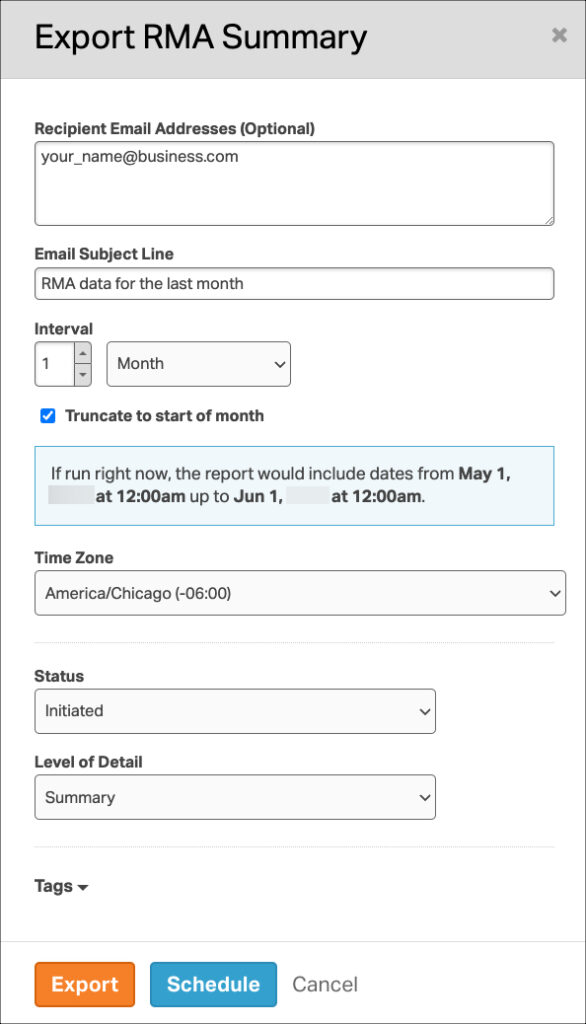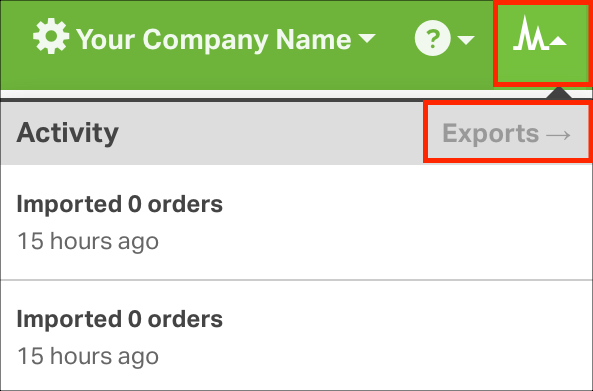With our RMA tracking system, you can easily export your RMA data to a CSV file format. This file give you the flexibility to analyze and manipulate the data according to your specific requirements.
Here are some ways in which leveraging RMA data can prove valuable:
- Product Quality Control:
- Gain valuable insights into the reasons behind product returns. By tracking patterns and analyzing the data, you can uncover recurring issues, defects, or design flaws.
- Cost Analysis:
- Access vital data for cost analysis and financial planning. Evaluate the frequency and reasons for returns to identify potential cost drivers such as manufacturing defects, shipping damages, or customer misuse.
- Warranty and Support Management:
- Efficiently manage and enforce product warranties with our RMA tracking system. Determine if a return falls within warranty terms, ensuring that your company provides appropriate support, repairs, or replacements to customers. This streamlined process enhances customer satisfaction and strengthens brand loyalty.
Topics
- How are the RMA Summary and Detail reports different?
- How to export RMA data
- RMA Summary / Detail column headers
How are the RMA Summary and Detail reports different?
RMA Summary
- There is one row per RMA.
- Product line information is not included. For example, SKUs and item names.
RMA Detail
- There is one row per RMA line (i.e., product in the RMA).
- For example, there will be three rows if an RMA includes three products.
See the comprehensive list of column headings in each report.
How to export RMA data
1. Go to the Returns tab -> select Export RMAs.
2. This will open the Export RMA modal. Choose from the options to customize the export:
- Recipient Email Addresses (optional)
- Comma-separated list of recipients for the Order report.
- Email Subject Line
- Customize the subject line of the report email.
- Interval
- Interval Options:
- Specific Date Range
- Hour
- Day
- Week
- Month
- If you select Hour, Day, Week, or Month – then Ordoro uses your current time to run the report.
- Example: if the current time is 9:18am, selecting “Hour” will return results from 8:18am to 9:18am.
- Truncate to start of hour / day / week / month
- By selecting this option, the report will run from the start of the chosen interval (minute 0) to the end of the same interval (minute 0).
- Example: if the current time is 9:18pm, selecting the truncate option will return results from 8:00am to 9:00am.
- Interval Options:
- Time Zone
- Status
- Choose which order status to include.
- Options: Initiated, Active, Finished, Cancelled, All
- Level of Detail
- Options: Summary, Detail
- See this section to understand the difference.
- Tags
- A dropdown list of all your tags
4. After entering your report parameters, click Export or Schedule.
- If you select Schedule, you’ll be prompted to create a report. See this support article for details.
5. Once the report is complete, it is available in the Activity Menu -> Exports.
6. Click the CSV button. The file will automatically download to your computer.
RMA Summary / Detail Column Headers
| Column | Order Summary | Order Detail |
|---|---|---|
| Reference ID | ✓ | ✓ |
| Original Order ID | ✓ | ✓ |
| Original Order Cart Name | ✓ | ✓ |
| Created Date | ✓ | ✓ |
| Updated Date | ✓ | ✓ |
| Status | ✓ | ✓ |
| Line Count | ✓ | ✓ |
| Tags | ✓ | ✓ |
| Warehouse Name | ✓ | ✓ |
| Customer Notes | ✓ | ✓ |
| Internal Notes | ✓ | ✓ |
| SKU | ◯ | ✓ |
| SKU Description | ◯ | ✓ |
| Category | ◯ | ✓ |
| Line Notes | ◯ | ✓ |
| Expected Qty | ◯ | ✓ |
| Received Qty | ◯ | ✓ |
| Restocked Qty | ◯ | ✓ |
| Line Total Price | ◯ | ✓ |
| Return Code | ◯ | ✓ |
| Email Sent Date | ◯ | ✓ |
| Shipment Date | ◯ | ✓ |
| Shipping Vendor | ◯ | ✓ |
| Shipping Method | ◯ | ✓ |
| Shipping Cost | ◯ | ✓ |
| Tracking Number | ◯ | ✓ |
| Ship From (Company Name) | ✓ | ✓ |
| Ship From (Name) | ✓ | ✓ |
| Ship From (Street1) | ✓ | ✓ |
| Ship From (Street2) | ✓ | ✓ |
| Ship From (City) | ✓ | ✓ |
| Ship From (State) | ✓ | ✓ |
| Ship From (Code) | ✓ | ✓ |
| Ship From (Email) | ✓ | ✓ |
| Ship From (Phone) | ✓ | ✓ |
| Ship From (Fax) | ✓ | ✓ |
| Ship From (Reference Number) | ✓ | ✓ |
| Ship To (Company Name) | ✓ | ✓ |
| Ship To (Name) | ✓ | ✓ |
| Ship To (Street1) | ✓ | ✓ |
| Ship To (Street2) | ✓ | ✓ |
| Ship To (City) | ✓ | ✓ |
| Ship To (State) | ✓ | ✓ |
| Ship To (Code) | ✓ | ✓ |
| Ship To (Country) | ✓ | ✓ |
| Ship To (Email) | ✓ | ✓ |
| Ship To (Phone) | ✓ | ✓ |
| Ship To (Fax) | ✓ | ✓ |
| Ship To (Reference Number) | ✓ | ✓ |
| Bill To (Company Name) | ✓ | ✓ |
| Bill To (Name) | ✓ | ✓ |
| Bill To (Street1) | ✓ | ✓ |
| Bill To (Street2) | ✓ | ✓ |
| Bill To (City) | ✓ | ✓ |
| Bill To (State) | ✓ | ✓ |
| Bill To (Code) | ✓ | ✓ |
| Bill To (Country) | ✓ | ✓ |
| Bill To (Email) | ✓ | ✓ |
| Bill To (Phone) | ✓ | ✓ |
| Bill To (Fax) | ✓ | ✓ |
| Bill To (Reference Number) | ✓ | ✓ |




